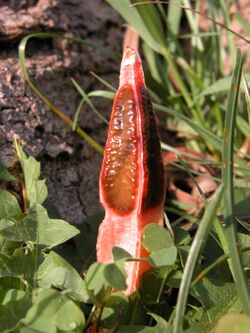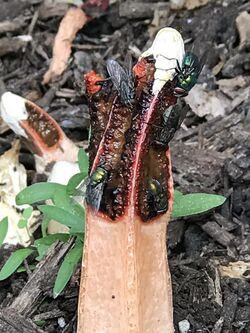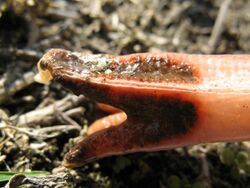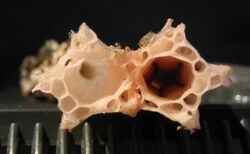Biology:Lysurus mokusin
| Lysurus mokusin | |
|---|---|

| |
| Scientific classification | |
| Domain: | Eukaryota |
| Kingdom: | Fungi |
| Division: | Basidiomycota |
| Class: | Agaricomycetes |
| Order: | Phallales |
| Family: | Phallaceae |
| Genus: | Lysurus |
| Species: | L. mokusin
|
| Binomial name | |
| Lysurus mokusin (Cibot ex Pers.) Fr.
| |
| Synonyms[1] | |
|
Species synonymy
| |
| Lysurus mokusin | |
|---|---|
| Mycological characteristics | |
| smooth hymenium | |
| hymenium attachment is irregular or not applicable | |
| stipe is bare | |
| spore print is olive-brown | |
| ecology is saprotrophic | |
| edibility: not recommended | |
Lysurus mokusin, commonly known as the lantern stinkhorn, the small lizard's claw, or the ribbed lizard claw, is a saprobic species of fungus in the family Phallaceae. The fruit body consists of a reddish, cylindrical fluted stipe that is capped with several "arms". The arms can approach or even close in on each other to form a spire. The gleba—an olive-green slimy spore mass—is carried on the outer surface of the arms. The fruit body, which has an odor comparable to "fresh dog feces", "rotting flesh", or "sewage" when mature, is edible in its immature "egg" stage. The fungus is native to Asia, and is also found in Australia, Europe and North America, where it is probably an introduced species. It has been used medicinally in China as an ulcer remedy.
History, taxonomy, and phylogeny
The species was first described by the Catholic Priest and missionary Pierre-Martial Cibot in the publication Novi Commentarii Academiae Scientiarum Imperialis Petropolitanae (New memoirs of the Imperial Academy of Sciences in St. Petersburg) (1775), where he reported finding it near Peking (now Beijing).[2] This finding represents the earliest published scientific record of a fungus from China.[3] Cibot's original name for the lantern stinkhorn, Phallus mokusin, was sanctioned by Christian Hendrik Persoon in his 1801 Synopsis Methodica Fungorum.[4] In 1823, Elias Magnus Fries transferred it to the genus Lysurus in his Systema Mycologicum.[5] L. mokusin is the type species of the genus Lysurus.[6]
In 1938, Y. Kobayasi reported the form L. mokusin f. sinensis, which he said differed from the main species in having a head that was more angular and conical at the top;[7] the form sinensis was also reported in Korea in 1995.[8] Some authors have attempted to define forms of L. mokusin as new species based on the degree of separation of the apical arms. For example, to contrast with his concept of Lysurus in which the arms were either free or slightly fused, the genus Lloydia was created by Chow in 1935 to contain species in which the tips of the arms were fused. As a result of various differing interpretations of the limits of L. mokusin, and the desire of some authors to define new species based on perceived differences, the fungus has acquired a lengthy list of synonyms over the years.[1]
L. mokusin is commonly known as the "lantern stinkhorn", the "small lizard's claw",[9] or the "ribbed lizard claw".[10]
Lysuris mokusin has been included in a large-scale phylogenetic analysis of Gomphoid and Phalloid fungi published in 2006, and was shown to form a clade with Simblum sphaerocephalum, Lysurus borealis, and Protubera clathroidea.[11]
Description
Immature fruit bodies of L. mokusin are white, gelatinous "eggs" measuring 1–3 cm (0.4–1.2 in) in diameter, and are attached to the ground by thickened strands of mycelium called rhizomorphs. As the fungus matures, the egg ruptures as the fruit body rapidly expands, leaving volval remnants behind at the base. The stipe of the hollow, spongy mature fruiting body has dimensions of 10–15 cm (3.9–5.9 in) by 1.5–2.5 cm (0.6–1.0 in), and ranges in color from white to pink to red, with 4–6 distinct deeply grooved sides divided lengthwise by ribs. The basis of distinction between L. mokusin and other species of Lysurus is the angular form of its stipe.[12] The sides branch out into 4–6 arms that are fused together at the tip to form a pointed apex, resembling a spire. As the mushroom matures, the arms may spread apart. The outer surface of the arms is coated by a brownish, slimy, foul-smelling spore mass called the gleba; its fetid odor helps it attract flies and other insects to assist in spore dispersal. The odor has been compared to "fresh dog feces",[13] "rotting flesh"[14] or sewage.[15]
The spores are cylindrical in shape, smooth, thin-walled, and hyaline (translucent), with dimensions of 4–6 by 2–2.5 µm.[15] Scanning electron microscopy reveals that one end of the spores has a hilar scar—an indentation in the spore wall that results during its separation from the sterigma of the basidium.[16] The basidia (spore-bearing cells) are usually eight-spored, and the gleba composed of chains of roughly spherical, fusiform, ellipsoid to broadly club-shaped cells that are either 6.5–7.4 by 2.8–5.6 µm or 37.1–46.3 by 18–28 µm and also mixed with filamentous cells 2.3–4.5 µm wide. The hyphae of L. mokusin have clamp connections.[8]
Similar species
Lysurus cruciatus is similar is appearance to L. mokusin, but has a cylindrical stem without any flutings at the tip. Lysurus borealis is also similar, but its stipe is not fluted, and without the angles present in L. mokusin.[17]
Edibility and other uses
This species is considered to be edible when still in the immature "egg" stage, and is thought to be a delicacy in China.[18] When mature, its foul odor would deter most individuals from attempting consumption. The fungus has been used medicinally in China as a remedy for ulcers.[19][20]
Habitat and distribution
Lysurus mokusin is saprobic, and grows solitarily or in small groups in forest litter, and wood chip mulch used in landscaping, and compost.[15] Documented sightings of L. mokusin include Australasia,[21] the Canary Islands,[12] Korea,[8] Japan ,[22] China (Fujian Province),[23] and the Bonin Islands.[24] The species was unknown in Europe until it was reported in Italy in 1979;[25] it is considered an alien species in that continent.[26] In the United States, it has been collected from the states of California ,[27] Texas , Northeast Oklahoma and Washington, D.C.[18] It was photographed in Frederick, Maryland on Sept 12, 2022.[28]
References
- ↑ Jump up to: 1.0 1.1 "Lysurus mokusin (L.) Fr. 1823". MycoBank. International Mycological Association. http://www.mycobank.org/MycoTaxo.aspx?Link=T&Rec=198749.
- ↑ Cibot P-M. (1775). "Descriptio Phalli quinquaguli seu fungi Sinensium Mo-ku-sin" (in Latin). Novi Commentarii Academiae Scientiarum Imperialis Petropolitanae 19: 373. https://books.google.com/books?id=8lQ-AAAAcAAJ&q=Novi%20Commentarii%20Academiae%20Scientiarum%20Imperialis%20Petropolitanae%201775&pg=PA373. See also the illustration on Table 5.
- ↑ "A brief historical survey of fungal taxonomy and floristics in China". Mycologia 73 (6): 1098–107. 1980. doi:10.2307/3759679.
- ↑ Persoon CH. (1801) (in Latin). Synopsis Methodica Fungorum. 2. Göttingen, Germany: Apud H. Dieterich. p. 245. https://books.google.com/books?id=UugVAAAAYAAJ&q=Synopsis%20Methodica%20Fungorum%20Persoon&pg=RA2-PA245-IA2.
- ↑ Fries EM. (1823) (in Latin). Systema Mycologicum. 2. Greifswald, Germany: Sumtibus Ernesti Mauritii. p. 286. https://books.google.com/books?id=5RMAAAAAQAAJ&q=Systema%20mycologicum%201823&pg=PA288.
- ↑ "Lysurus Fr.". MycoBank. International Mycological Association. http://www.mycobank.org/MycoTaxo.aspx?Link=T&Rec=19209.
- ↑ Kobayasi Y. (1938). "Hymenogastrineae et Phallineae". Nova Flora Japonica. Tokyo, Japan: Sanseido Co. p. 52.
- ↑ Jump up to: 8.0 8.1 8.2 "Higher Fungi in Korea" (PDF). Korean Journal of Mycology 23 (2): 144–52. 1995. http://koix.kisti.re.kr/root_resolution.jsp?koi=KISTI1.1003/JNL.JAKO199503040109369.
- ↑ "Common names of the fungi of North America". The Mushroom Hunter. http://www.mushroomhunter.net/common%20names.pdf.
- ↑ A Field Guide to Mushrooms, North America. Boston, Massachusetts: Houghton Mifflin. 1987. p. 345. ISBN 0-395-91090-0. https://books.google.com/books?id=kSdA3V7Z9WcC&q=lysurus+mokusin&pg=RA1-PA344.
- ↑ "Molecular phylogenetics of the gomphoid-phalloid fungi with an establishment of the new subclass Phallomycetidae and two new orders". Mycologia 98 (6): 949–59. 2006. doi:10.3852/mycologia.98.6.949. PMID 17486971.
- ↑ Jump up to: 12.0 12.1 "Gasteromycetes on the Canary Islands: Some noteworthy new records". Mycotaxon 67: 439–53. 1998. http://www.cybertruffle.org.uk/cyberliber/59575/0067/0439.htm.
- ↑ Armstrong WP.. "The Amazing World of Fungi". Wayne's Word: An On-Line Textbook of Natural History. http://waynesword.palomar.edu/ww0504.htm#Herb.
- ↑ "Lysurus mokusin". California Fungi. http://www.mykoweb.com/CAF/species/Lysurus_mokusin.html.
- ↑ Jump up to: 15.0 15.1 15.2 Smith KN. (2005). A Field Guide to the Fungi of Australia. Sydney, NSW, Australia: University of New South Wales Press. p. 198. ISBN 0-86840-742-9. https://books.google.com/books?id=ysgx509xB-AC&q=lysurus+mokusin&pg=PA198.
- ↑ "Ultrastructural studies of Clathraceae and Phallaceae (Gasteromycetes) spores". Mycologia 74 (1): 166–68. 1982. doi:10.2307/3792646.
- ↑ North American Mushrooms: a Field Guide to Edible and Inedible Fungi. Guilford, Connecticut: Falcon Guide. 2006. p. 481. ISBN 0-7627-3109-5. https://books.google.com/books?id=zjvXkLpqsEgC&q=lysurus+mokusin&pg=PA481.
- ↑ Jump up to: 18.0 18.1 Kuo M. "Lysurus mokusin: The Lantern Stinkhorn". MushroomExpert.Com. http://www.mushroomexpert.com/lysurus_mokusin.html.
- ↑ Rolfe F. (1974). The Romance of the Fungus World: An Account of Fungus Life in its Numerous Guises, both Real and Legendary. New York, NY: Dover Publications. p. 142. ISBN 0-486-23105-4. https://books.google.com/books?id=BQBNC8pABzoC&q=lysurus+mokusin&pg=PA142.
- ↑ Icons of Medicinal Fungi from China. Beijing, China: Science Press. 1987. pp. 474–75. ISBN 7-03-000195-8.
- ↑ Cunningham GH. (1931). "The Gasteromycetes of Australasia. XI. The Phallales, part II.". Proceedings of the Linnean Society of New South Wales 56 (3): 182–200.
- ↑ Dring DM. (1980). "Contributions towards a rational arrangement of the Clathraceae". Kew Bulletin 35 (1): 1–96. doi:10.2307/4117008.
- ↑ Huang N-L. (1985). "Notes on Phalalles from Fujian China" (in Chinese). Wuyi Science Journal 5: 211–18. ISSN 1001-4276.
- ↑ Hongo T. (1978). "Higher fungi of the Bonin Islands. Part 2". Kinjin Kenkyusho Kenkyū Hōkoku (Reports of the Tottori Mycological Institute) 16: 59–65. ISSN 0388-8266.
- ↑ Nonis U. (1979). "Presence in Italy of Lysurus mokusin new record" (in Italian). Micologia Italiana 8 (2): 39–41. ISSN 0390-0460.
- ↑ Delivering Alien Invasive Species Inventories for Europe (2009). "List of species alien in Europe and to Europe". Handbook of Alien Species in Europe. Invading Nature – Springer Series in Invasion Ecology. Berlin: Springer. p. 140. ISBN 978-1-4020-8279-5.
- ↑ "Clathraceae in California". Madroño 16 (2): 33–42. 1961.
- ↑ "Instagram". https://www.instagram.com/p/CiaraKXuESw/?igshid=YmMyMTA2M2Y=.
Wikidata ☰ Q3003975 entry
 |




